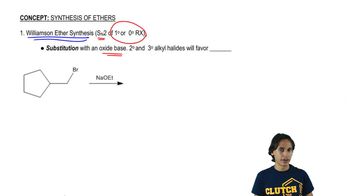Here are the essential concepts you must grasp in order to answer the question correctly.
Ethers and Their Formation
Ethers are organic compounds characterized by an oxygen atom bonded to two alkyl or aryl groups. They can be synthesized through the condensation of two alcohols, where water is eliminated. This reaction is known as the Williamson ether synthesis, which typically requires the use of strong acids or bases to facilitate the reaction and improve yield.
Recommended video:
Alcohols and Their Reactivity
Alcohols are organic compounds containing one or more hydroxyl (-OH) groups. Their reactivity is influenced by the structure of the alcohol, such as whether it is primary, secondary, or tertiary. Primary alcohols generally undergo condensation reactions more readily than secondary or tertiary alcohols, which may lead to elimination or rearrangement instead of ether formation.
Recommended video:
Alternative Methods for Ether Synthesis
When ethers cannot be formed through direct condensation of alcohols, alternative methods such as the Williamson ether synthesis can be employed. This method involves the reaction of an alkoxide ion with a primary alkyl halide, allowing for the formation of ethers without the limitations posed by the structure of the alcohols involved in condensation reactions.
Recommended video:
The Mechanism of Williamson Ether Synthesis.
 Verified step by step guidance
Verified step by step guidance Verified Solution
Verified Solution



 4:33m
4:33m